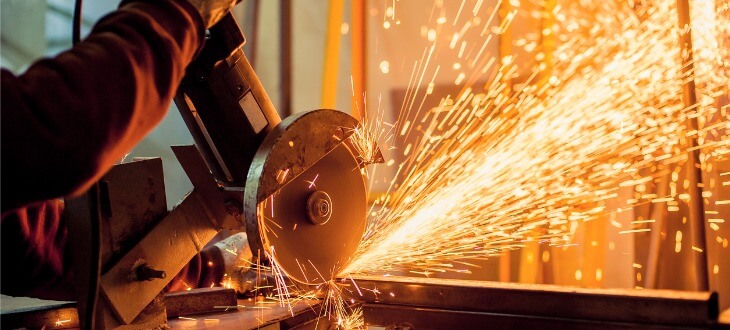Stainless steel is a strong and durable metal used in construction, manufacturing, and different DIY projects. However, due to its hardness, it can be difficult to cut. There are many different tools and techniques to cut stainless steel. The best method will vary depending on the thickness of the steel and your desired finish.
There are many ways you can cut through stainless steel. This article will explore how to cut through stainless steel sheets, specifically with a circular saw. We will outline the materials you’ll need and the steps to take.
Why use stainless steel?
There are many reasons you could use stainless steel:
- Hygienic: Stainless steel is non-porous, which means it does not harbor bacteria.
- Recyclability: Stainless steel is one of the few materials that is 100% recyclable, which makes it a highly sustainable material.
- Cost-Effectiveness: Not only can stainless steel last many years, but it is highly cost-effective.
Where is stainless steel used?
Stainless steel is used in a ton of industries and instances, including:
- Construction: Stainless steel is used for a variety of construction projects, including roofing, siding, and railings.
- Food Processing: Since stainless steel does not keep bacteria on it, it is ideal for mixers, conveyors, and storage tanks.
- Automotive: The automotive industry uses it for components such as exhaust systems, mufflers, and fuel tanks.
- Medical Devices: Once again, this does not retain bacteria, making it a good use for surgical instruments, implants, and IV tubes.
- DIY Projects: You can use stainless steel for various DIY projects because it’s so cost-effective. You can make things like wall art, trinkets, and more.
Benefits of Cutting Stainless Steel
There are many benefits of cutting stainless steel. They include:
- Versatility: You can cut your stainless steel into a variety of shapes and sizes. This makes it versatile for a wide range of projects.
- Strength: Stainless steel is a strong and durable material that can withstand wear and tear.
- Corrosion Resistance: Stainless steel is resistant to corrosion. This makes it a good choice for applications where the material will be exposed to water or other chemicals.
- Aesthetics: Stainless steel is sleek and modern. This means stainless steel can complement a variety of design styles.
Materials You’ll Need
The following are some materials you will need to cut stainless steel.
- Circular saw
- Diamond saw blade
- Work table
- Clamps
- Soap
- Water
- Cloth
- Safety equipment: safety glasses, work gloves, and face mask
How to Cut Stainless Steel Sheets in 6 Steps
Step 1. Suit up With Your Safety Gear
Before starting, put on your safety gear to protect yourself from potential hazards. Remember to take your time and be cautious, as the material can be tough, and the blade can be very sharp. Always prioritize safety and follow manufacturer guidelines for your circular saw and blade.
Step 2. Choose the Right Blade
Make sure you have the appropriate stainless steel cutting blade for your circular saw. Diamond blades are commonly used because they can handle the material.
Step 3. Secure the Stainless Steel and Mark the Cut Line
Place the stainless steel piece on a stable work surface, and use clamps to secure it firmly. This will prevent the metal from moving during the cutting process and ensure a straight cut. Then, use a marker, chalk, or scribe to draw the cut line on the stainless steel where you want to make the cut. Double-check your measurements.
Step 4. Set the Saw Depth and Position
Adjust the cutting depth of the circular saw to slightly deeper than the thickness of the stainless steel. This will prevent the blade teeth from touching the work surface and reduce potential kickback. Align the saw blade with the marked cut line you drew on the stainless steel.
Step 5. Start the Saw and Make the Cut
Turn on the saw and let the blade reach full speed before cutting. Once at full speed, slowly guide the saw along the cut line. Apply steady pressure to the saw to maintain a consistent cutting speed. Avoid forcing the blade through the metal, as it can cause the saw to overheat and wear the blade prematurely. Continue cutting along the marked line until you have completed the cut. Make sure to keep your hands clear of the blade!
Step 6. Cool, Turn Off, and Deburr
Cutting stainless steel generates heat, which can damage the blade or the material. If you notice the blade or stainless steel becoming too hot, you can stop cutting temporarily and use a coolant or cutting oil to cool the area. Once you’re done cutting, turn off the circular saw and wait for the blade to come to a complete stop before setting it aside. Depending on the blade used and the quality of the cut, you may need to remove any burrs or sharp edges from the cut edge of the stainless steel using a deburring tool or a metal file.
Visit Tampa Steel & Supply for Quality Metal and Metal Processing Services
Do you need help with metalworking and keeping your metal fresh? The experienced professionals at Tampa Steel & Supply are here to help. We provide the highest quality of services to our customers.
Request a Quote Online
Or Call Tampa Steel & Supply at (813) 241-2801

